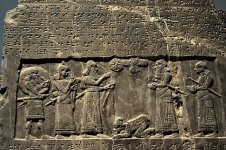Origen
Well-known member
- Joined
- Jan 1, 2021
- Messages
- 817
- Gender
- Male
- Religious Affiliation
- Christian
- Acceptance of the Trinity & Nicene Creed
- Yes
Below is a relief from the Black Obelisk of Shalmaneser III. What you see is the only known portrayal of an Israelite or Judean king in ancient Near Eastern art. That fellow bowing down is Jehu king of North Israel and he is paying tribute to Shalmaneser III king of Assyria.


The inscription, written in Akkadian, reads:
“I received the tribute of Iahu [i.e. Jehu] son of Omri: silver, gold, a golden bowl, a golden vase with pointed bottom, golden goblets, golden buckets, tin, a royal scepter staff and javelins."
See Assyrian Reliefs from the Palace of Ashurnasirpal II: A Cultural Biography, pp. 127-128.
Now here is the interesting point. Jehu was not the son nor a descendent of King Omri. Jehu overthrew the house of Omri, specifically Jehoram who was the son of Ahab, the son of Omri. In the O.T. this line is known as the house of Ahab.


The inscription, written in Akkadian, reads:
“I received the tribute of Iahu [i.e. Jehu] son of Omri: silver, gold, a golden bowl, a golden vase with pointed bottom, golden goblets, golden buckets, tin, a royal scepter staff and javelins."
See Assyrian Reliefs from the Palace of Ashurnasirpal II: A Cultural Biography, pp. 127-128.
Now here is the interesting point. Jehu was not the son nor a descendent of King Omri. Jehu overthrew the house of Omri, specifically Jehoram who was the son of Ahab, the son of Omri. In the O.T. this line is known as the house of Ahab.
